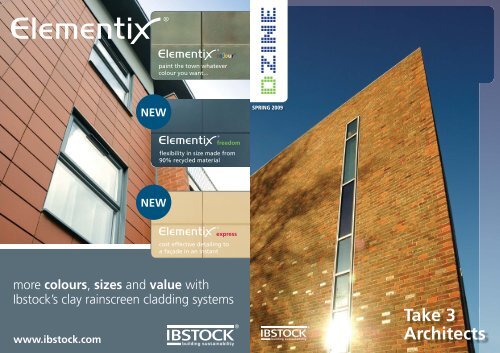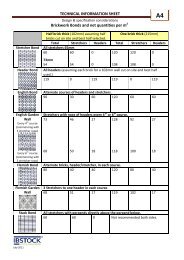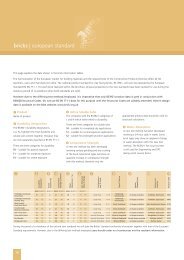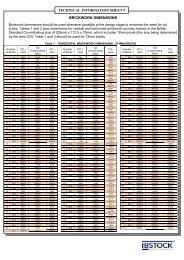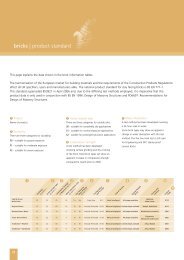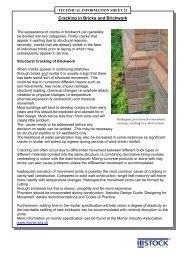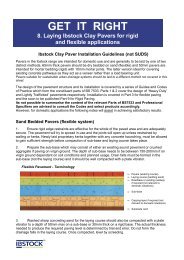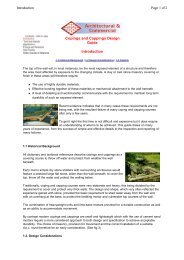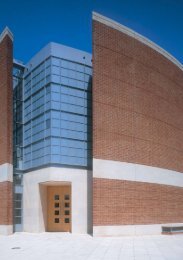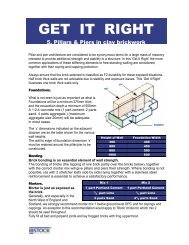Take 3 Architects - Ibstock
Take 3 Architects - Ibstock
Take 3 Architects - Ibstock
Create successful ePaper yourself
Turn your PDF publications into a flip-book with our unique Google optimized e-Paper software.
NEW<br />
paint the town whatever<br />
colour you want...<br />
freedom<br />
flexibility in size made from<br />
90% recycled material<br />
more colours, sizes and value with<br />
<strong>Ibstock</strong>’s clay rainscreen cladding systems<br />
www.ibstock.com<br />
NEW<br />
colour <br />
express<br />
cost effective detailing to<br />
a façade in an instant<br />
SPRING 2009<br />
<strong>Take</strong> 3<br />
<strong>Architects</strong>
2<br />
News from the Editor<br />
Spring 2009<br />
IBSTOCK DZINE MAGAZINE<br />
Published by:<br />
<strong>Ibstock</strong> Brick Ltd, <strong>Ibstock</strong>, Leicestershire, LE67 6HS<br />
Editor: Anne Grose<br />
Tel: 01530 261999 Email: marketing@ibstock.co.uk<br />
Contents<br />
News 2<br />
Stedman Blower 4<br />
Bovis Homes 6<br />
Feilden Clegg Bradley Studios 8<br />
Back to Basics - A Brick is a Brick? 10<br />
Brick Awards 2008 12<br />
Welcome to the first issue of 2009 and one that is<br />
a little bit different to previous issues.<br />
Over the past few months we have talked to<br />
three architects about how they feel about<br />
brick as a material and while they universally<br />
agree that they like it, it is interesting to hear<br />
their differing reasons why.<br />
We also have a four page feature on the 2008<br />
Brick Awards which were one of the most<br />
successful years ever for <strong>Ibstock</strong>. Projects<br />
featuring <strong>Ibstock</strong> bricks won 9 out of the 13<br />
available categories, proving yet again that<br />
when it comes to outstanding design the best<br />
brick to use is one made by <strong>Ibstock</strong>.<br />
New Birtley Products<br />
Two new products further extend the attractive range of traditional<br />
waterstruck bricks from Birtley. The Cumberland Blend combines both red<br />
and brown multi-coloured bricks. The Millhouse Blend is a subtle mix of buff<br />
multi and brown bricks giving the product a traditional northern cottage feel.<br />
Cumberland<br />
Blend<br />
Millhouse<br />
Blend<br />
Technical Topic<br />
Bricklaying in winter<br />
During winter months the British weather can range from positively<br />
<br />
construction if significant drops in temperature are not considered and<br />
planned for.<br />
The effect of freezing temperatures on brick laying<br />
Cold temperatures will slow the rate of hydration of the cement leading<br />
to delays in setting and reducing the rate of strength gain.<br />
<br />
suffer from disruptive expansion. The bond will be lost between brick and<br />
mortar and brickwork may have to be taken down and rebuilt.<br />
What can be done?<br />
Keep the bricks as dry as possible prior to use. The drier they are the more<br />
absorptive they will be to form an initial bond and the less likely to<br />
<br />
Bricklaying should be halted if the temperature drops to 3C and looks like<br />
it may continue to fall.<br />
Elementix Express ®<br />
Launched less than three months ago, Elementix Express ® has met with<br />
universal approval and is causing quite a stir. The first project is already<br />
completed and another 15 projects are in the pipeline for early this year.<br />
As the only UK manufactured rainscreen cladding system and having<br />
the backing of <strong>Ibstock</strong>, it is no wonder that it has proved an instant hit.<br />
The first project features 30 sq m of natural red on a residential building<br />
in Glasgow. All the tiles were installed on the rails in just one day, the<br />
rainscreen forms a feature panel above the entrance on the front of<br />
the building.<br />
Elementix ® Express has been engineered with the installer in mind<br />
to ensure ease and speed of construction. The range of natural clay<br />
colours and surface finishes add definition and detailing can be added<br />
to a façade in an instant.<br />
Key Features<br />
<br />
<br />
<br />
<br />
Sizes<br />
150mm<br />
Colours<br />
400mm<br />
450mm<br />
500mm<br />
225mm<br />
400mm<br />
35mm 450mm<br />
35mm<br />
500mm<br />
Natural Finish | Blue 5221 Natural Finish | Cream 5222 Natural Finish | Red 5200<br />
Technical Data<br />
Recommencing work on a site still covered in frost or snow could mean<br />
<br />
Always cover freshly laid brickwork with suitable amounts of hessian<br />
or similar, then overlay with an impervious material such as polythene.<br />
Proprietary waterproof fleeces are available.<br />
As the development of mortar strength takes longer at lower<br />
temperatures there may be the temptation to add accelerators. These are<br />
generally only effective in mass concrete, not thin sections of mortar and<br />
may damage wall ties if they are calcium chloride based.<br />
<br />
could also adversely affect cement hydration.<br />
To improve frost resistance of fresh mortar, the provision of air spaces<br />
where ice can expand can be achieved by using an air-entraining agent.<br />
The air bubbles also make the mortar easier to work and therefore allow<br />
a decrease in the amount of water. However, air entrained admixtures<br />
rely on accurate dosage and mixing as excessive air contents will<br />
dramatically reduce bond strength. Also adequate protection from<br />
<br />
Size Total System Weight Tile Weight Durability Transverse Strength<br />
(Impact Resistance)<br />
Water Absorption Tolerance<br />
400mm x 150mm 65Kg/m2 3.6Kg Frost Resistant Category E to BS 8200 < 8% +/- 1mm<br />
450mm x 150mm 65Kg/m2 4.0Kg Frost Resistant Category E to BS 8200 < 8% +/- 1mm<br />
500mm x 150mm 65Kg/m2 4.5Kg Frost Resistant Category E to BS 8200 < 8% +/- 1mm<br />
400mm x 225mm 65Kg/m2 5.4Kg Frost Resistant Category E to BS 8200 < 8% +/- 1mm<br />
450mm x 225mm 65Kg/m2 6.1Kg Frost Resistant Category E to BS 8200 < 8% +/- 1mm<br />
500mm x 225mm 65Kg/m2 6.8Kg Frost Resistant Category E to BS 8200 < 8% +/- 1mm<br />
For further information visit the website www.ibstock.co.uk or telephone: 0844 8004576<br />
3
4<br />
Stedman Blower,<br />
Farnham<br />
12.5mm plasterboard with vcl<br />
beam and block<br />
Rheinzinc standing seam roof<br />
dsal vapour barrier lapped<br />
up and into brickwork<br />
cavity tray stepped with fall of roof<br />
perp ends left open to form weep<br />
holes<br />
concrete lintel<br />
narrow section aluminium<br />
windows<br />
<strong>Ibstock</strong> specials PL2 and<br />
PL4 to form opening<br />
timber cill internally<br />
facing brickwork <strong>Ibstock</strong><br />
Swanage handmade<br />
100mm full fill cavity wall<br />
insulation<br />
concrete block<br />
<strong>Ibstock</strong> special plinth brick PL2<br />
shadow gap skirting detail<br />
floor finish on 65mm screed and<br />
underfloor heating pipes<br />
beam and block flooring<br />
The practice was founded in<br />
1895, deep in the history and<br />
traditions of arts and crafts.<br />
Twelve years ago Damien and<br />
his brother Robert Blower<br />
took over the practice from<br />
their father which means they<br />
are the fourth generation to<br />
run Stedman Blower.<br />
We talked to Damien Blower on how he<br />
has moved the company into a slightly<br />
new direction from the typical market<br />
town architect with a lot of school work to<br />
principally into residential work with private<br />
clients and how he feels about brick.<br />
“ In the last twelve years architecture has<br />
changed – with programmes like Grand<br />
Designs, people are a lot less conservative<br />
and more open to new ideas – sustainability<br />
has triggered in people a desire to think<br />
about architecture as more than just<br />
an ordinary building and think about it in<br />
terms of its technology and how it is built.<br />
Now our clients do get involved in the<br />
making of the building – they engage in the<br />
materiality of the building and the quality.<br />
People want to create something quite<br />
lasting through the design of their building<br />
and they want the architect to produce<br />
something quite special.<br />
This part of Surrey is particularly well known<br />
for its Arts and Crafts architecture. Stedman<br />
Blower uses these influences in their work<br />
including locally sourced brick and tiles in<br />
their designs. As a company they have<br />
worked on Lutyens buildings and other Arts<br />
and Crafts masterpieces all of which use<br />
local materials.<br />
Damien also spent four years working for<br />
Frank Gehry in America which gives an<br />
organic feel to his work. His ambition in<br />
residential architecture is to fuse modernism<br />
and the Arts and Crafts tradition. He likes to<br />
use modern ideas in his designs.<br />
Brick is a fundamental material to the<br />
traditions of British architecture – providing<br />
a solid feeling, with mass and scale. The feel<br />
of brick is at the core of all the designs that<br />
the company produces. It is contemporary<br />
– part of the heritage and brick connects<br />
people to their cultural beginnings.<br />
Brick is able to be used in a very<br />
contemporary fashion and clients feel more<br />
comfortable with using a material that is<br />
tried and tested. They like things that are<br />
solid and will last. People connect with<br />
different architects in the kind of materials<br />
that they use and it becomes a part of who<br />
they are.<br />
Architecture should give a powerful sense<br />
of place and should encompass the cultural<br />
traditions of a particular locality. This<br />
is one of the main reasons why we use<br />
brick as it gives that real sense of place.<br />
Sustainability is driving this forward. There<br />
is too much short termism coming forward<br />
in some architecture which destroys the<br />
environment.<br />
For the future we would like to push the<br />
boundaries with the technical properties<br />
of brick and do some cutting edge designs<br />
with brick on the edge of its performance.<br />
I also think in the future brick will be used<br />
more as a warming environment and will<br />
encourage more use of it as a material.”<br />
One project that shows the contemporary<br />
twist of Stedman Blower’s work is Little<br />
Park Farm – a new farmhouse built two<br />
years ago.<br />
“<br />
Architecture should give<br />
a powerful sense of place<br />
and should encompass<br />
the cultural traditions of<br />
a particular locality.<br />
”<br />
Little Park Farm, Ashstead Brick Type: Romsey Handmade Multi<br />
5
6<br />
Bovis Homes<br />
As one of the most successful house builders<br />
in the construction industry, Bovis Homes has a longestablished<br />
reputation for the design and quality of<br />
the homes it builds across England and Wales.<br />
To find out more about why Bovis Homes’<br />
designs and specifications are so well-respected,<br />
we spoke to the Company’s Group Architectural<br />
Director, Keith Pye.<br />
Brick is of course “ a tried and tested material, used<br />
for centuries and has an excellent<br />
track record in producing durable,<br />
quality homes.<br />
”<br />
“As a company we’ve always had a strong<br />
preference for brick, based on its solid<br />
aesthetic appeal and the benefit it offers of<br />
being robust and with low-maintenance –<br />
qualities that are greatly appreciated by our<br />
customers.<br />
Compared with other materials such as<br />
render, weather boarding or even tilehanging,<br />
we find brick a very cost-effective<br />
and attractive finishing material for a new<br />
home. Other options can require extra<br />
maintenance, which for the customer is<br />
often an important consideration when<br />
buying a new home. For many purchasers<br />
brick is much the preferred option.”<br />
Due to its longevity and design flexibility,<br />
brick is also a firm favourite for Bovis Homes.<br />
Brick with its many types and forms - also<br />
lends itself to design diversity, a number<br />
one factor in producing a good urban<br />
development.<br />
Keith said: “When designing an urban<br />
Keith said: “In our experience we prefer using a quality brick and less<br />
render on a new development, as by using a quality brick it helps<br />
ensure the building itself is more durable and is built to last.”<br />
development with a high proportion<br />
of homes, it is important to create an<br />
environment which is aesthetically pleasing;<br />
provides a sense of place and is an area in<br />
which people aspire to live.<br />
Good urban design provides landmark<br />
buildings, attractive, varied street scenes and<br />
creates pleasant vistas and a feeling of place<br />
and community.<br />
This can all be achieved through a<br />
combination of measures - through good<br />
development design, by using varying house<br />
types and by the external materials used.<br />
The huge range of quality bricks now<br />
available helps us to create developments<br />
and homes that are interesting, attractive<br />
and varied.”<br />
The use of brick is also important to<br />
Bovis Homes for its sustainability value.<br />
Keith said: “If manufactured locally,<br />
brick stocks require little transport and<br />
their production helps support the local<br />
economy. If a local brick is used on a new<br />
development in the area, the added benefit<br />
is that the homes will suit the environment<br />
in which they are built. In turn this helps<br />
us meet one of the main conditions often<br />
stipulated by local planning authorities –<br />
that the design of our homes and external<br />
materials used, complements existing<br />
housing and natural surroundings.<br />
The versatility and benefits offered by ‘the<br />
everyday brick’ make it, for us, one of the<br />
best products for the purpose – building<br />
quality homes in attractive designs.”<br />
“<br />
The huge range of<br />
quality bricks now<br />
available helps us to<br />
create developments<br />
and homes that are<br />
interesting, attractive<br />
and varied.<br />
”<br />
7
8<br />
Feilden Clegg Bradley<br />
Studios, Bath<br />
Second Floor - Level 4<br />
Founded in 1978 and with<br />
offices in Bath and London,<br />
Feilden Clegg Bradley Studios<br />
is a substantial practice with<br />
an international reputation for<br />
design quality, environmental<br />
expertise and architectural<br />
innovation.<br />
The Company’s approach was recognised<br />
<br />
prestigious architectural award, presented to<br />
Accordia, a scheme which is widely regarded<br />
as setting a new benchmark for housing<br />
in the UK. We talked to Matt Vaudin, one<br />
of the partners of FCB about how brick’s<br />
sustainability credentials have influenced<br />
their choice of material.<br />
“We tend towards brick because of the<br />
sustainability aspects of it – you can often<br />
find a factory that is near so it can be a local<br />
material. It also helps us with the U-values<br />
– you can’t do glass anymore because you<br />
can’t get the required U-values but with a<br />
brick skin you can achieve the right U-values.<br />
We have also started to use bricks with<br />
lime mortar which we have found very<br />
interesting. It allows you to think more<br />
sustainably about the bricks because they<br />
can be reused as the lime mortar doesn’t<br />
glue the bricks together. Lime mortar<br />
gives us more sustainability credentials<br />
because cement produces a lot more<br />
CO 2 and therefore is not so good for the<br />
environment.<br />
We have also started to do some research<br />
into using unfired bricks both in the UK<br />
and in South Africa where we have done<br />
a couple of projects using local mud bricks.<br />
In the UK we used unfired <strong>Ibstock</strong> bricks to<br />
build internal walls for part of a project for<br />
Neal’s Yard which was very successful.<br />
1m<br />
N<br />
Runnymede Civic Offices, Chertsey Brick Type: West Hoathly Dark Multi Stock, Wakehurst Multi Stock & Clinkers<br />
Clients are interested in what their buildings<br />
will be made from, all projects now need to<br />
have BREEAM Excellent and so all materials<br />
need to be A+ so again brick helps us to<br />
achieve this.<br />
The other thing that has helped is that now<br />
<strong>Ibstock</strong> are producing long thin bricks which<br />
recreates the style that was only previously<br />
available by buying Dutch bricks. Obviously<br />
being able to source UK manufactured<br />
products is much more sustainable than<br />
bringing them in from Europe.<br />
Our latest project for Runnymede – their<br />
new civic offices – also uses lime mortar<br />
but we wanted to create a very specific<br />
East-West Section<br />
aesthetic look – a tweedy effect. We had<br />
seen a German brick that created this but<br />
wanted to source a local brick and we<br />
found three bricks from West Hoathly that<br />
would recreate the look. Interestingly we<br />
also added a fourth brick to get the blend<br />
which were the overburnt bricks, so that<br />
the bricks that are normally wasted at the<br />
bottom of the kiln were also spotted within<br />
the brickwork and give it another layer of<br />
texture.<br />
The design for Runnymede started off<br />
just about transparency and being able<br />
to see into the offices but ended up also<br />
being driven by using local bricks and<br />
sustainability”.<br />
“<br />
In the UK we used<br />
unfired <strong>Ibstock</strong> bricks<br />
to build internal walls<br />
for part of a project for<br />
Neal’s Yard which was<br />
very successful.<br />
1m<br />
”<br />
9
10<br />
Back to Basics<br />
Hand-made stock<br />
A Brick is a Brick?<br />
Not so, there are a number of<br />
manufacturing methods which give a brick<br />
its characteristics.<br />
Here are the main manufacturing processes<br />
and the resulting brick texture.<br />
Soft mud moulding or ‘stock’ bricks.<br />
This covers a number of processes where bricks<br />
are formed in mould boxes. There are several<br />
methods but all have a common theme. Soft<br />
clay is thrown into a mould, a mould release<br />
medium prevents the clay from sticking to the<br />
<br />
The excess clay is struck off from the top of the<br />
mould and the bricks are turned out. The term<br />
‘stock’ originates from hand-making times as it<br />
was the piece of wood used to hit the mould<br />
against to release the clay.<br />
In its most simple form this is done by hand by<br />
a craftsman who would produce one brick at<br />
a time. This is labour intensive but produces<br />
a unique appearance.<br />
Hand-made Stock – clots of clay are hand<br />
thrown into sanded mould boxes.<br />
Traditional<br />
Hand-made<br />
Machine moulded stock<br />
For a less labour intensive version, large automated<br />
machines can replicate the hand-making process.<br />
By using banks of mould boxes on a continual circuit, the<br />
boxes are washed, sanded, filled with clots of clay, struck<br />
off level and the formed brick turned out.<br />
When the clay is dropped into moulds a creased effect<br />
can be achieved by coating the clots of clay in damp sand.<br />
Regulating the dampness of the sand dictates the extent<br />
of the creasing.<br />
Another method is to press soft clay into a mould using<br />
a metal plate to scoop clay from the mixing chamber or<br />
‘kettle’ and press it firmly down into the mould creating<br />
an even, sandy texture.<br />
Machine<br />
moulded stocksand-creased<br />
Machine moulded<br />
stock-sand-faced<br />
Clots of clay are transported along conveyors to be dropped<br />
into the prepared mould boxes.<br />
Water-struck<br />
A variation of this process is ‘water-struck’ where water is<br />
used as the release medium.<br />
Bricks are formed by pushing soft clay into<br />
a wet revolving mould with a static base.<br />
Excess clay is struck off. As the mould moves<br />
on, the base is no longer holding the clay<br />
in place. A steel plate pushes the moulded<br />
clay the rest of the way through the aperture<br />
to a conveyor belt below. A relatively even,<br />
sand free texture is achieved with a slight<br />
‘lip’ evident on the lower aris, formed when<br />
the mould moves away from its base.<br />
Brick shrinkage from ‘green’<br />
to fired.<br />
Calculations of the shrinkage rate of the<br />
clay are made after assessing laboratory<br />
test results. Mould boxes and formers<br />
are made larger than the end product to<br />
<br />
water intensive ‘green’ pre-dried stage to<br />
finished fired product.<br />
The ‘frog’<br />
As a general rule, moulded bricks tend to<br />
incorporate a rectangular indentation known<br />
as a ‘frog’. It is thought that the term dates<br />
back to the days when ponies were used as<br />
transport in the brickyards. Their hoof marks<br />
in the mud showed a similar indent, from<br />
the horses hoof “frog”.<br />
The Th Extrusion E t i Process P<br />
Water-struck<br />
Where ‘stock’ bricks use hand or machine<br />
force to compact clay in a mould, the<br />
extrusion process utilises a vacuum chamber<br />
to de-air the clay before it is formed. The<br />
clay body is mixed to a fairly stiff texture and<br />
is then fed into an extruder where a worm<br />
screw pushes it along a barrel into a vacuum<br />
chamber which compresses it through<br />
a taper and out through a die.<br />
The die is made up from adjustable steel<br />
plates and is set larger than the intended<br />
<br />
much the clay will shrink during the drying<br />
and firing process. The clay emerges as<br />
a continuous brick shaped column before<br />
being cut, by a set of tensioned wires, to<br />
<br />
Initially the extrusion is very smooth but it<br />
can be modified by removing a thin sliver<br />
of clay from the top and sides using a taut<br />
wire to produce a ‘drag-faced’ effect,<br />
serrated blades can be arranged to produce<br />
a ‘rusticated’ finish or textured rollers can<br />
be placed over the column to create<br />
a ‘rolled’ finish. The column of clay can<br />
also be blasted with sand.<br />
<strong>Ibstock</strong>’s ‘Fireborn’ product during the extrusion<br />
process. A ‘die’ can be modified to accomodate<br />
various size formats.<br />
Serrated blades are used to achieve a roughened<br />
surface by ‘peeling’ back the outer surface of<br />
the clay.<br />
Extruded bricks are generally perforated but<br />
can be solid but not frogged. Engineering<br />
bricks are manufactured using this process.<br />
This outlines the processes used to<br />
give brick their textural qualities. A wealth<br />
of techniques can achieve the desired<br />
colour range.<br />
Perforations<br />
Since the advent of the European<br />
Specification for masonry units, BS EN771-1,<br />
multi perforated products are emerging<br />
from British manufacturing plants. This<br />
relaxation of the void volume limit in British<br />
products has resulted in savings on fuel as<br />
drying and firing times can be shortened.<br />
The Code of Practice for the Use of Masonry,<br />
BS 5628 was revised in 2005 to take into<br />
account changes to calculation figures that<br />
may result.<br />
Wire-cut W<br />
sandfaced s<br />
Wire-cut W<br />
smooth s<br />
Wire-cut W<br />
drag-faced<br />
d<br />
Wire-cut W<br />
rolled r<br />
Wire-cut W<br />
rolled r<br />
Wire-cut W<br />
rusticated r<br />
Wire-cut W<br />
rusticated r<br />
11
12<br />
Brick Awards<br />
2008<br />
At the 2008 Brick Awards held in London on 5th November<br />
2008, <strong>Ibstock</strong> scooped nine of the thirteen awards including<br />
the Supreme Winner.<br />
<strong>Ibstock</strong> has been a leading supporter of architecture and architectural teaching in the UK<br />
for well over 25 years providing funding for university study trips, lectures and regional<br />
RIBA competitions. This, coupled with the Company’s nationwide network of Design<br />
Advisors, has helped provide architects with the level of support and knowledge needed to<br />
produce winning designs.<br />
Over the next two pages we look at the winning projects in a little more detail.<br />
Best Commercial Project & Supreme Winner<br />
Best Private Housing Development<br />
THE BARGE ARM DEVELOPMENT, GLOUCESTER<br />
Architect: Edward Cullinan <strong>Architects</strong><br />
Brickwork Contractor: Cowlin Construction<br />
Brick: <strong>Ibstock</strong>: Birtley Olde English<br />
The Judges enjoyed the way in which this new building<br />
acknowledges its context by taking clues from the existing<br />
warehouses without slavishly copying them. Whilst there<br />
are a number of materials used externally, the brickwork<br />
provides a unifying theme that is fundamental to the<br />
success of the composition. The buildings create a number<br />
of external spaces that enhance the experience of living in<br />
these well designed apartments.<br />
NEW MUSIC BUILDING, LATYMER<br />
UPPER SCHOOL, LONDON<br />
Architect: van Heyningen & Haward<br />
Brickwork Contractor: R Durtnell & Sons<br />
Brick: <strong>Ibstock</strong>: Berkshire Orange Stock<br />
This building links together a number of buildings on<br />
the site and creates a new set of spaces at the heart<br />
of the School. There is a limited palette of materials<br />
all of which combine well with the brick to produce a<br />
convincing design solution.<br />
Best International Project<br />
2 HOUSES IN KILLINEY<br />
Architect: ABK <strong>Architects</strong><br />
Brickwork Contractor: Cedar Building Company<br />
Brick: <strong>Ibstock</strong>: Chailey Stock/Hamsey Multi Stock Paver<br />
Sustainability Award<br />
The Judges found many features to admire in this excellent<br />
development. The architectural concept and its realisation,<br />
the relationship of building to site, the use of landscaping<br />
elements and the skill of the craftsman who built it. A<br />
worthy winner of a close fought category<br />
NEW HEAD OFFICE, FITZPATRICK<br />
CONTRACTORS, HODDESDON<br />
Architect: Black Architecture<br />
Brickwork Contractor: Newton Brickworks<br />
Brick: <strong>Ibstock</strong>: Tudor Brown Blend<br />
The Judges were impressed by the high standard of entries in<br />
this category, proof that Clients and Designers are beginning<br />
<br />
Contractors commissioned their own Headquarters with the<br />
intention of making it a demonstration project for Sustainability.<br />
They have been successful in delivering a building that is rated<br />
‘BREEAM Excellent’. Every aspect of Sustainability has been<br />
considered especially the contribution of brick in forming an<br />
elegant and practical façade to this outstanding building.<br />
13
14<br />
MARLBOROUGH BRICKWORK<br />
Projects included:<br />
Project: Sheffield University Student Village, Sheffield<br />
Brick: <strong>Ibstock</strong>: Brunswick Autumn<br />
Specialist Brickwork<br />
Contractor of the Year<br />
Project: <br />
Brick: <strong>Ibstock</strong>: Atlas Smooth Red/Northdale Cedar Red<br />
This is a company with an excellent record in Health and Safety<br />
that provides training and development to all levels of Staff and<br />
has an all-encompassing management system. Nearly 80% of their<br />
contracts are negotiated repeat business and when you see the<br />
Special Award<br />
THE LOVELACE MAUSOLEUM, ST MARY’S<br />
CHURCH, EAST HORSLEY<br />
Architect: The John Deal Practice<br />
Brickwork Contractor: Chris Anstey<br />
Brick: <strong>Ibstock</strong> & Handmades to Match<br />
The Judges chose to mark the restoration of the Lovelace<br />
Mausoleum with a Special Award. The close cooperation<br />
between Architect and Contractor has resulted in a<br />
spirited restoration which even involved the Contractor in<br />
making some of his own special bricks. The restoration of<br />
this building has been a labour of love on the part of all<br />
concerned.<br />
quality of their work it is not surprising. Best Innovative Use of Brick<br />
& Clay Products<br />
HAIR SALON, BELFAST<br />
Architect: Jamison <strong>Architects</strong><br />
Brickwork Contractor: MPS Construction<br />
Brick: <strong>Ibstock</strong>: Birtley Olde English<br />
The Judges considered this project an excellent<br />
demonstration of the adage that if the designer makes<br />
the effort to exploit brickwork it is possible to produce<br />
innovative and striking results without breaking the bank.<br />
Volume Housebuilding<br />
Award<br />
DAVID WILSON HOMES<br />
Project: Heron’s Landing<br />
Brick: <strong>Ibstock</strong>: Cheddar Red/Cheddar Golden/<br />
Audley Red Mixture Stock<br />
Project: Eton Court<br />
Brick: <strong>Ibstock</strong>: Parham Red Stock/Berkshire Orange Stock<br />
Project: The Hermitage<br />
Brick: <strong>Ibstock</strong>: Surrey Orange/Surrey Cream Multi<br />
The Judges thought that these three schemes<br />
demonstrated the Developer’s sensitivity to the potential of<br />
different sites and a determination to produce high quality<br />
homes whatever the location. They were impressed by the<br />
consistently high standard of finish in the buildings and the<br />
variety of designs on offer.<br />
15


